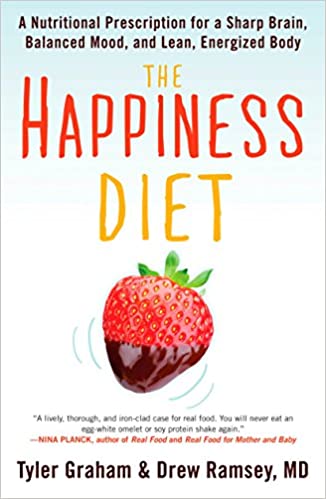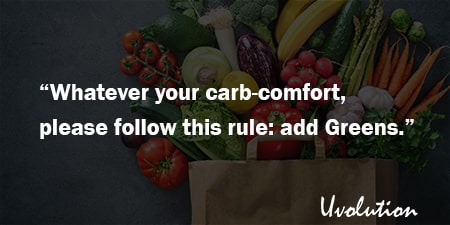The Happiness Diet by Tyler Graham & Drew Ramsey
The Book in 1 Sentences
“What if you discovered that the best place to begin your personal pursuit of happiness is at the end of your fork?
Emerging research from the fields of neuroscience and nutrition shows that by changing what you eat, you can improve your mental and emotional well-being. You can stabilize your moods. You can improve your focus. You can even make your brain grow.
So what do we mean by happiness? There have been many books published in recent years that explore different approaches to attaining happiness—some from motivation speakers, others from experts in the field of positive psychology.
At their core these are suggestions for behavioral changes that are meant to improve your psychological well-being and outlook on life. We are coming at this from a very different perspective:
Before you start changing your outlook on life to improve your emotional well-being, we want to make sure your eating behavior is the best it can be so that the master mood regulator—the brain—is provided with what it needs to be strong, sharp, healthy ... and happy.
Increasingly, in our experience, it seems that fewer people truly feel they have control over their diet. ‘It’s just too hard to eat right,’ we often hear. ‘Everyone says something different’ is another refrain we get a lot.
We want to change this state of affairs and settle the confusion about what needs to be eaten for a happy, healthy brain and body. The Happiness Diet provides concrete tools (tasty ones, too) for doing just that.” ~ Tyler Graham and Drew Ramsey, MD
6 BIG Ideas
1. The Modern American Diet (MAD)
2. 100 different reasons to avoid processed foods
The Happiness Diet Book Summary
1. The Modern American Diet (MAD)
“Thanks to the introduction of industrial-scale food processing, Americans have changed their
dietary habits more in the past 100 years than all of humanity had in the previous 100,000.
The Modern American Diet—we call it the MAD—is characterized first and foremost by large
amounts of simple sugars and refined carbohydrates now found in everything from cereal to
pasta.
These sugars play tricks on your brain, so you keep craving more of them, even though
excess consumption of these foods actually contributes to the shrinkage of key areas of your
brain responsible for everything from memories to mood regulation.
The second largest source of calories in the MAD are added fats—refined vegetable and seed
oils that have high amounts of omega-6 fats as well as trans fats, which have been linked to an
increased risk of depression.
A third critical aspect of the MAD most detrimental to our brain functioning is the factory farming of cows, pigs, chickens, and even fish. Not only are these creatures pumped full of antibiotics and hormones to promote their growth, but they feed on an unnatural diet of grain, which leaves their flesh deficient in many of the very fats and nutrients our brains have required from animals since the dawn of humankind.
Strange as it seems, with the MAD you can expand your waistline and starve your brain at the same time, which is exactly what growing numbers of Americans are doing.
Study after study in the medical research journals confirm that people who are most dependent on MAD-style eating habits have increased levels of depression, anxiety, mood swings, hyperactivity, and a wide variety of other mental and emotional problems.
Our belief, backed up by ample research, is that the best way to prevent the MAD assault on our health and happiness is to go back to eating the wholesome foods that nurtured the development of our brains over millions of years of evolution.”
“It might be surprising to hear, but sugar is a relatively new food in our diet. For the vast majority of human existence, no one had access to this sweet substance.”
“Over the course of the past two hundred years, we’ve increased our sugar intake by 3,000 percent. This is the single biggest change to the human diet since the invention of fire.”
“While the brain accounts for about 2 percent of your body’s weight, it burns 20 percent of your body’s fuel. That’s because the brain is the body’s command center—the most complex
supercomputer ever created.”
“Animal fat—the kind that doesn’t come from factory-farm animals eating unnatural diets—is anything but unhealthy for the human body. It’s what we’ve been subsisting on for tens of thousands of years. It’s what your body was designed to eat.”
2. 100 different reasons to avoid processed foods
“Deciphering food label ingredients leads to unappetizing results. Take the innocuous-sounding castoreum, which is used to enhance the flavor of puddings, candies, and some frozen dairy desserts. You might be surprised to know that it’s derived from beavers—beaver anal glands.”
“A large study recently published in the British Journal of Psychiatry found that eating processed foods, such as refined carbohydrates, sweets, and processed meats, increased the risk of depression by about 60%. Eating a wholefood diet, on the other hand, decreased the risk of the disease by about 26%.”
“When we’re told to cook meat thoroughly to prevent foodborne illness, it’s not because raw meat is inherently dangerous, but rather because cooking factory-produced meat thoroughly helps to kill off any dangerous bacteria that might be lurking in our hamburgers.”
3. The formula for brain happiness
“The pursuit of happiness takes consistent effort. This is why a lean, energized body is so vital
to cognitive functioning, emotional regulation, and anxiety.
When you have a lot of energy, cognitive tasks are easier to accomplish, frustrations easier to bear, and anxiety is less likely to overwhelm you. Proper brain nutrition creates a strong foundation from which you can create the life you want.
Here’s our formula for brain happiness in its simplest form:
• Clear thinking and focused attention = a greater ability to plan and execute.
• Steady and content moods = a greater ability to absorb the frustrations of life and regulate
your emotions.
• Freedom from needless worry = turning your wheels, not spinning them.
PLUS
• Energy to engage = a vibrant pursuit of all of life’s possibilities.
Achieving these ideals is possible only through a well-fed, well-nourished brain. It is interesting, though, that nearly all the most common prescriptions for improving cognitive functioning involve mental exercises such as puzzle-solving, and most treatments for emotional regulation and anxiety lean toward psychotherapy and medication.
These remedies all have benefits, but dietary change is rarely suggested as a solution—even though the brain, like any other body organ, is highly reliant on a good diet for proper functioning.”
“Some of these studies show more conclusive results than others, but the one result
you will never see is one that shows that the MAD improves cognitive function. Or that MAD
foods deter depression. Or that those whose diets rely on MAD sugars and vegetable oils have lower rates of anxiety, dementia, or depression.
The MAD is a hands-down loser when it comes to your mental, emotional, and physical well-being. It is so bad for you that you have to wonder how such a thing could ever develop and what the people who created it were thinking.
Here’s a hint: They weren’t thinking about your happiness.”
4. Get rid of Carbage
“The word sugar is synonymous with carbohydrate. All plants are constructed of sugars, and
popularly we know these as complex carbohydrates. So whether we’re talking about romaine
lettuce or oats or asparagus, these are all complex carbohydrates.
The opposite, of course, is known as simple carbohydrates or simple sugars. These are plants that have been refined and processed to create things like pasta, bread, pizza dough, and fruit juice.
Collectively, we refer to these foods as ‘carbage,’ or carbohydrate garbage. They make up the majority of calories in the MAD lifestyle. Whether it comes in the form of soda or pasta, carbage is one of the main dietary culprits behind America’s uptick in weight and downtick in happiness.
Carbage is so new to our diet that our bodies don’t have off switches to tell our brains when we’ve eaten enough of these simple sugars—but protein, fat, and complex carbohydrates have these ‘switches.’
When we eat meats, dairy, and whole vegetables, they tell our digestive and nervous systems that we’ve had enough and should stop eating. Your body knows when you’ve eaten your fill of whole foods.”
Mark Hyman - in his book Eat Fat, Get Thin - says: “A quality carbohydrate will contain both phytonutrients and fiber. It will be whole and unprocessed and have had a very short distance from field to fork.
How many ‘processing steps’ does broccoli need to get to your plate? Hardly any—just cut it off the stalk, wash off the dirt, steam or saute, and voila, it’s on your plate.
If your food took a pit stop in a factory, you might want to reconsider eating it unless you can still recognize it, like an artichoke in a can or jar, or a nut that has been removed from its shell.
A quality carb will not contain refined flours, additives, preservatives, fillers, sweeteners, dyes, or any other ingredient normally found in processed foods.
Bottom line: If you can’t pronounce an ingredient or recognize it as originating from nature, don’t eat it!”
“When humans hunted and gathered their food, they ate a much wider variety of plants. ... One of the most pristinely preserved of these humans’... stomach was stuffed with an astonishing 66 different species of plants—an astonishing variety considering today we only eat about twenty different plants.”
5. Start slowly
“If you hit your local drive-thru a few times a week or are used to eating refined carbohydrates and sugars every day, you might want to ease into things.
People fail at making dietary changes for several reasons, but one we’d like you to check at the door is catastrophizing, or all-or-nothing thinking.
Moving in the right direction, even generally, is progress. Period. You can’t ruin a diet or your health with a single meal or fast-food binge. The best way to keep smiling is to keep trying.”
6. We’re voting with every dollar we spend
“Good food, healthy food for America is something that people of all political and economic stripes should agree on. We should all desire to give our children food that grows brains ready to engage with the world and poised to learn all that our schools have to offer.
So next time you pick up your fork, remember that you’re not just making a decision that impacts your mood and waistline—you’re also choosing what kind of country you want to live in.”
That was my QUICK summary of the great book The Happiness Diet by Tyler Graham & Drew Ramsey. If you’re interested, get your copy. There is a HUGE amount of life-changing ideas in this book, and we’ve only touched on a tiny bit of it.
Buy The Book: The Happiness Diet by Tyler Graham & Drew Ramsey

GET Blinkist 7 Days FREE Trial
3000+ Book Summaries
(Audio and Text)








